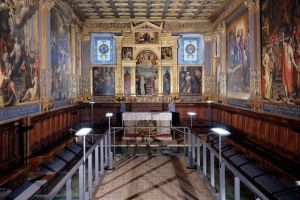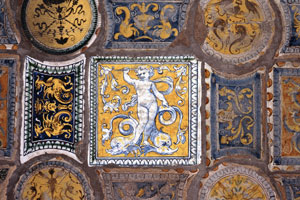The Shrine of the House of Saint Catherine
Kitchen Oratory
This room encompasses the space once occupied by the Benincasa family’s kitchen, the fulcrum of domestic life. Visible through the grille under the altar are the remnants of the ancient fireplace on the opposite wall; in this very fireplace, while a fire was burning, Catherine fell during one of her ecstatic trances, but she was miraculously unharmed. The Saint spent the first phase of her life within the walls of her home, amid unceasing prayer, penance, and moments of contemplation and conversation with the Eternal Father, until the moment when God called her to concrete action in support of the Church and the Papacy, culminating in her trip to Avignon, the greatest diplomatic initiative of the fourteenth century in Europe, whose result was the return of the papal seat to Rome.
In 1482-1483, about a century after Catherine’s death, the Confraternity of Saint Catherine chose this spot as the meeting place for its members, who soon thereafter placed the panel painted in 1496 by the Sienese artist Bernardino Fungai on the back wall above the altar. The painting, in all probability commissioned by the Saracini family, one of the most important in Siena, presents in the central compartment the episode of Catherine receiving the stigmata, the most sublime moment of her spiritual journey. At the time that the picture was painted, the crucifix from which Catherine received the . . .





